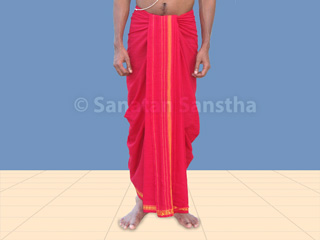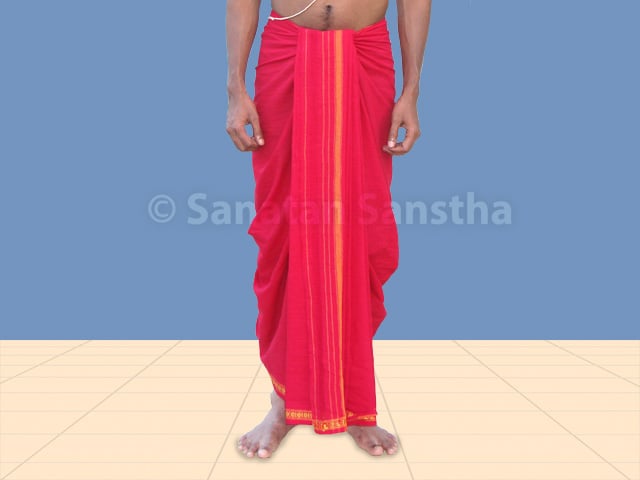1. Introduction
A dhotī is a rectangular piece of unstitched cloth, usually around 4-5 metres long, wrapped around the waist and the legs and knotted at the waist by Hindus. It is made from a continuous thread of cotton. Natural thread has sāttviktā and Chaitanya. Since the thread used in a dhotī is continuous, its sāttviktā and Chaitanya also remains in the dhotī in a continuous state, and gives similar benefit to the individual who wears it.
2. Method of wearing a dhotī
There are two common methods of wearing a dhotī. It is worn either by ‘Shatakachha’ method, that is, tucking it at six places, or by tying a knot near the navel. Depending on the local custom, the method of wearing it may vary slightly from region to region. It is most convenient to learn to wear a dhotī from an individual who normally wears it or who knows how to wear it.
3. Benefits of wearing a dhotī
3A. A dhotī is worn at the navel and hence, provides complete protection from attacks of negative energies
‘A dhotī is worn at the navel. A layer of the dhotī pleats is formed over the navel. As a result, the navel is completely protected from the attacks of negative energies. When the navel is exposed, negative energies find it very easy to attack it and through it, transmit distressing energy all over the body. This can harm all the organs in the abdomen.
3B. Pleats of the dhotī give an uninterrupted supply of Chaitanya to the surrounding region, due to which the distressing energy there gets destroyed
Wearing the dhotī around the navel forms five or more layers of pleats, one over the other. This retains the inherent Chaitanya in the dhotī. Hence, the individual that wears a dhotī gets the benefit of this Chaitanya the entire day. Due to the layer of pleats that are tucked behind at the waist level, Chaitanya is supplied uninterruptedly to the region below the waist, and the distressing energy there gets destroyed. Of the nine orifices in human body, the genital openings and the anus are more prone to attacks of negative energies. Since a protective sheath in the form of pleats is formed over these regions, the individual remains continuously protected from the attacks.
3C. Chaitanya is supplied to the Mūlādhār-chakra (First chakra [Centre] in the spiritual energy system located in the region between the anus and the base of the genitals in the subtle-body) due to the pleats
Pleats tucked in the front, meaning, at the navel region, protect the navel, Swādishṭhān-chakra (Second chakra in the spiritual energy system located in the region of the genitals in the subtle body) and all the organs in the abdomen. Pleats tucked behind at the waist level supply Chaitanya to the Mulādhār-chakra. This weakens the ‘centre of desires’ present in the Mulādhār-chakra, and such an individual learns to lead a restrained life. Additionally, if this individual performs spiritual practice, his desires reduce faster and he makes swift spiritual progress.
3D. Chaitanya from the pleats formed in the dhotī continuously protects the individual
Method of wearing the dhotī creates a formation of pleats that covers the legs of the individual. It imparts motion to the Chaitanya within the dhotī and it begins to flow all over the individual’s body. A ring of Chaitanya is also formed around the individual, thus protecting it continuously.’
4. Automatically conducted
analysis based on subtle-knowledge, in the
context of benefits obtained upon wearing a dhotī
4A. Analysis based on subtle-knowledge done by a seeker: Void created by a dhotī disintegrates the yantra (A device/shape used by a subtle-sorcerer to store negative energy in order to trouble a seeker / individual) that emits distressing energy present in the body, and the white colour of the dhotī repulses the attacks of negative energies originating from the external atmosphere.
4A 1. I perceived that the lower region of the body was imbibing greater proportion of distressing energy emitting from Pātāl (Hell region). To counter this distressing energy, a special void was created in the dhotī and the void was instantly absorbing the distressing energy entering the body.
4A 2. Similarly, I perceived that the void in the dhotī was disintegrating the effects of the negative energies on the body and the yantra in the body that was emitting distressing energy.
4A 3. I perceived that the white colour of the dhotī was repulsing the attacks of negative energies originating from the external atmosphere. (White colour symbolises nirguṇ [Non-materialised] Principle).
4A 4. I perceived large scale disintegration of distressing energy in the Brahmarandhra (Opening in the spiritual energy system located on the crown in the subtle body) because of the dhotī.
4B. Analysis based on subtle-knowledge conducted by a seeker
4B 1. The individual who wears a dhotī receives continuous flow of Chaitanya from it, which reduces the distressing covering on the individual, makes it introverted and inculcates Divine virtues in it.
I perceived that the dhotī is an energy source of Chaitanya. When worn, the dhotī forms a shape of the English letter ‘W’ in the region of the legs. From its mid-point, this energy is emitted as a continuous flow in the upward direction towards the individual. (Perceived that upon standing in front of a lit frankincense, the smoke spreading upwards envelops the whole body.) I perceived that just as Shrī Lakshmīdēvi stands in a lotus, the individual stands in a dhotī, which is a Divine sheath. The individual that wears a dhotī remains continuously immersed in the flow of Chaitanya. Subjecting the individual continuously to Chaitanya results in reduction in its distressing covering. This helps in making the individual introverted and nurtures Divine virtues.
4B 2. Changes perceived in seekers who suffer from negative energy distress upon wearing a dhotī
When seekers in the Ashram, who suffer from negative energy distress, wore dhotī–kurtā instead of a pant and shirt, I perceived reduction in their distress. I also felt calm upon looking at them.
4B 3. Changes perceived in a seeker who suffered from severe negative energy distress, who regularly wore a pant and shirt, and later began wearing half-sleeves kurta and dhotī regularly
-
Expressions of aggressiveness and anger that were previously apparent on the seeker’s face reduced. The seeker’s own presence was more noticeable than that of the māntrik (A subtle-sorcerer).
-
As the control of māntrik on the seeker’s mind became less, the emotional turmoil in the seeker’s mind also reduced. I perceived that this calmed him.
-
The seeker became mentally stable at the level of bhāv (Spiritual emotion). I perceived that this change was conducive to implementing the process of spiritual practice from within.
-
As a result of these benefits, feeling of calmness, bhāv and Ānand (Bliss) were perceived on his face. I also perceived humility and composure in his behaviour.
4B 4. Remembering Shrīvishṇu upon looking at the dhotī of a seeker
On Māgha Krushṇa 12, Kaliyug Varsh 5110 (21.2.2009), when I looked at the dhotī of a seeker, for a moment I perceived that the colour of the dhotī was pink and I remembered Shrivishṇu. I felt as if the seeker was standing within a Divine sheath.’
– Ranjana
5. Spiritual experiences of spiritual healing
taking place on the self upon looking at others who wore a dhotī
5A. Upon looking at a child-seeker who wore a dhotī, I perceived reduction in the distressing covering around me, and experienced lightness on my face.
5B. Upon looking at a priest-seeker who wore a dhotī, spiritual distress reduced and I felt calm
On Mārgashīrsha Krushṇa 9, Kaliyug Varsh 5110 (31.12.2008), upon looking at a priest-seeker who wore a dhotī, my spiritual distress reduced and I felt calm. I developed bhav towards the seeker as if towards a Deity. I perceived manifestation of divinity around him due to the sāttvik clothes he was wearing. The divinity in him had an effect on my mind causing spiritual healing to take place on me. As a result, the existence of māntrik in me lessened and I started feeling my own existence, accompanied by awakening of bhāv as well.
6. Spiritual experiences obtained upon wearing a dhotī
6A. Spiritual experiences obtained due to spiritual healing
6A 1. Experienced reduction in psychological depression and spontaneous commencement of chanting and prayers upon wearing a dhotī, which led to performing every action with bhāv
‘On Shrāvaṇ Shukla 9, Kaliyug Varsh 5110 (10.8.2008), I was unable to reach the expected level in my individual spiritual practice in aspects such as praying, chanting of God’s Name hence, I was deeply disturbed. Two hours were lost in this manner. Suddenly, I recollected having read an article by Pūjya (Dr.) Mukul Gadgil which was published in ‘Dainik Sanatan Prabhat’ on ‘How Chaitanya is imbibed upon wearing a dhotī’. I wore a dhotī immediately. Soon, I found that my praying and chanting commenced automatically. The next day I was depressed again. However, within 15-20 minutes I thought of wearing a dhotī. I felt better again upon wearing it.’
(Psychological depression in the seeker was due to negative energy distress. Wearing a dhotī effected spiritual healing on him and reduced his depression. – Compiler)
6B. Positive spiritual experiences
Bhāv was awakened upon wearing a dhotī and remembering Deity Pānḍurang (Shrivishnu)
-
Upon wearing a dhotī my bhāv was awakened.
-
Upon looking at the pleats of the dhotī, I perceived that, ‘they symbolise Saptadēvatā (Seven superior Deities – Shrī Gaṇēsh, Deity Shiva, Shrīrām, Deity Hanumān, Deity Datta, Shrī Durgādēvī and Shrīkrushṇa) and that they are protecting me’.
-
Upon looking at the pleats, I remembered Deity Pāndurang (Shrivishnu) and felt that these pleats were those of His pitāmbar (Yellow silk dhotī).’
Reference: Sanatan Sanstha’s Holy Text ‘Spiritually beneficial clothes for men’


